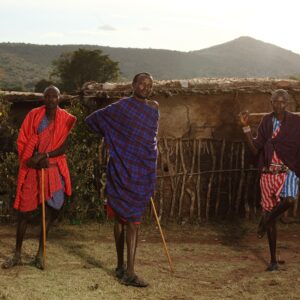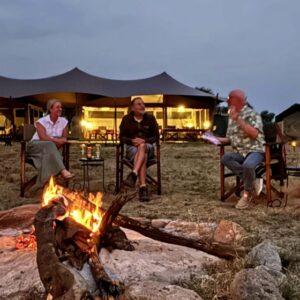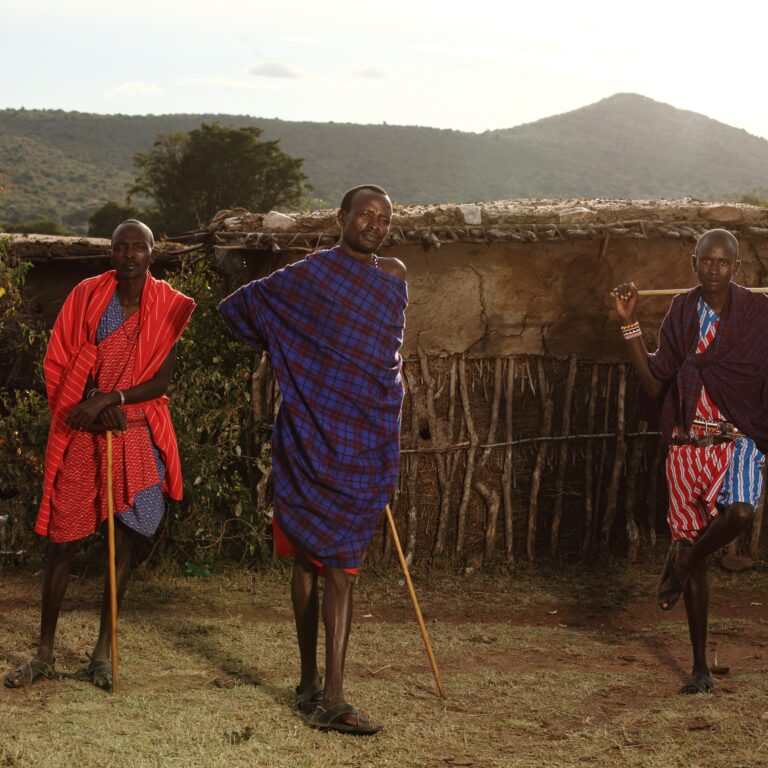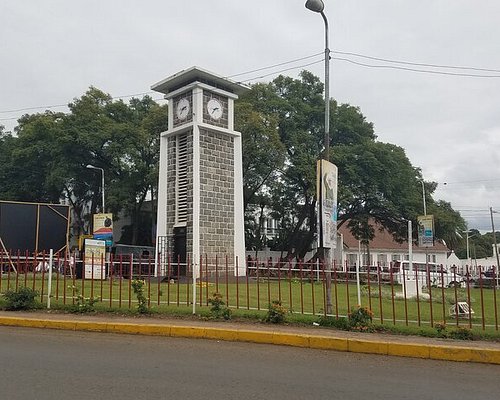The “Big Five” animals on a Tanzania safari are the lion, leopard, elephant, rhinoceros, and buffalo. These animals were historically considered the most challenging and dangerous to hunt on foot, and are now a major draw for wildlife enthusiasts and photographers. For decades, the term “Big Five” has been the rallying cry for safari enthusiasts, symbolizing the pinnacle of African wildlife viewing. Originating from the challenging and dangerous nature of hunting these animals on foot, today, the “Big Five” refers to the five most iconic and sought-after mammals to spot during a safari: the Lion, Leopard, African Elephant, Black Rhinoceros, and African Buffalo.
Tanzania, with its vast and pristine national parks, stands as one of the world’s premier destinations to embark on this ultimate wildlife quest. A Tanzanian safari offers not just the chance to see these magnificent creatures, but to witness them thriving in their natural habitats, behaving as they have for millennia. Understanding each member of this formidable quintet is key to appreciating the profound experience of a Big Five safari.
1. Lion (Panthera leo): The King of the Savanna
The undisputed monarch of the African plains, the Lion is the largest and most social of Africa’s big cats. Known for their majestic manes (on males) and powerful roars, lions live in prides, complex social units that cooperate in hunting and raising cubs. Spotting a pride lounging under an acacia tree, or witnessing a lioness stalking her prey at dawn, is a quintessential safari moment. Their sheer power, regal demeanor, and social dynamics make them a captivating subject.
2. Leopard (Panthera pardus): The Elusive Master of Stealth
Often considered the most elusive and challenging of the Big Five to spot, the Leopard is a solitary and nocturnal hunter renowned for its incredible stealth and camouflage. These powerful felines are master climbers, frequently seen resting draped over a tree branch, where they also hoist their kills to keep them safe from other predators like lions and hyenas. A leopard sighting, with its distinctive rosette-patterned coat, is a true privilege and a testament to a keen-eyed guide.
3. African Elephant (Loxodonta africana): The Gentle Giant
The largest land animal on Earth, the African Elephant is a symbol of strength, wisdom, and family bonds. These magnificent creatures roam the savannas in herds led by a wise matriarch, constantly communicating through rumbles and trumpets. Their presence shapes the landscape, as they push over trees to forage and create pathways. Witnessing a herd of elephants, especially with playful calves, interacting at a waterhole is a deeply moving and unforgettable experience.
4. Black Rhinoceros (Diceros bicornis): The Critically Endangered Survivor
The Black Rhinoceros is the most critically endangered member of the Big Five, making a sighting incredibly rare and special. These solitary browsers are identifiable by their hooked upper lip (adapted for grasping leaves and twigs) and two prominent horns. Their dwindling numbers are a stark reminder of the devastating impact of poaching. Thanks to intensive conservation efforts in protected areas, Tanzania offers some of the best chances to spot these prehistoric-looking survivors, making every encounter a powerful moment for conservation awareness.
5. African Buffalo (Syncerus caffer): The Formidable Grazer
Often underestimated, the African Buffalo is a formidable and powerful animal, known for its unpredictable temperament and immense strength. These large bovines form massive herds that can number in the thousands, grazing the vast plains and wallowing in mud holes. Their distinctive boss (a solid shield of bone across the forehead of males) makes them instantly recognizable. Their sheer numbers and imposing presence are a constant feature of the Tanzanian safari landscape.
Interesting Fact About the Big 5 Animals on a Tanzania Safari
The term “Big Five” was coined by big-game hunters in Africa, referring to the five most difficult and dangerous animals to hunt on foot. It was never about their physical size, but rather the challenge and risk involved in pursuing them. Today, the term has been reappropriated by the tourism industry to represent the most iconic and sought-after wildlife sightings on a safari, symbolizing the ultimate photographic trophy rather than a hunting one.
Where to See the Big 5 Animals on a Tanzania Safari
Tanzania offers several world-class destinations where your chances of spotting all of the Big Five are exceptionally high. To see the “Big Five” (lion, leopard, elephant, rhino, and buffalo) on a Tanzania safari, the Ngorongoro Crater and Serengeti National Park are your best bets. These areas are known for their high concentration of these iconic animals, and you have a good chance of spotting all five during a visit.
Ngorongoro Conservation Area (Ngorongoro Crater). This is arguably the best single location in Tanzania for a realistic chance of seeing all the Big Five in a single day. The craters’ contained ecosystem and high density of animals make sightings frequent and often very close.
Serengeti National Park. The vast plains of the Serengeti are excellent for lions, elephants, buffalo, and leopards (especially in riverine areas). While black rhino sightings are rare, they do exist. The sheer abundance of other wildlife makes this a must-visit.
Tarangire National Park. Renowned for its enormous elephant herds and large buffalo populations. Lions and leopards are present, though rhinos are absent.
Ruaha National Park. In the Southern Circuit, Ruaha boasts massive elephant herds, large lion prides, and good leopard sightings. Rhinos are extremely rare here.
Nyerere National Park (formerly Selous Game Reserve). Known for large populations of elephants and buffalo, with good chances for lions and leopards. Rhinos are very rare.
Where to Stay During the Big 5 Tanzania Safari
Accommodation options for a Big Five safari in Tanzania range from comfortable to ultra-luxurious, designed to immerse you in the wilderness while providing exceptional service. For a Big 5 Tanzania safari, consider staying in lodges and camps within or near Serengeti National Park and Ngorongoro Crater. Options range from budget-friendly to luxurious, including tented camps and lodges, with some offering unique experiences like stargazing or close-up wildlife viewing. Book Big Five Tanzania Safari: Explore Africa’s Iconic Wildlife.
Luxury Lodges. Offer opulent rooms, gourmet dining, swimming pools, and often private decks with stunning views. Found in all major parks. Tented Camps (Mid-Range to Luxury). Provide a more authentic safari feel with spacious, well-appointed tents (often with en-suite bathrooms and proper beds). These can be permanent or mobile, moving with the Great Migration for optimal viewing.
Mobile Camps. Specifically designed to follow the Great Migration, offering prime viewing opportunities throughout the year. They provide a high level of comfort while being closer to the action. Budget Campsites. Available in some parks for those on a tighter budget, requiring your tour operator to provide camping gear. Most safari packages are all-inclusive, covering your accommodation, meals, game drives, and park fees.
What to Pack for a Big 5 Tanzania Safari
Packing smart is crucial for a comfortable and enjoyable safari experience. For a Big Five Tanzania safari, pack light, neutral-colored clothing, comfortable walking shoes, a hat, sunscreen, insect repellent, binoculars, and a camera with extra memory cards. Don’t forget a basic first-aid kit, any personal medications, and a power adapter for your electronics.
Clothing. Layers are key. Pack lightweight, breathable, quick-drying clothing in neutral colors (khaki, olive green, tan, brown) to blend in and avoid attracting insects. Include a warm fleece or light puffy jacket for chilly early mornings and evenings, and a waterproof/windproof outer shell. Long sleeves and pants offer sun and insect protection. Footwear. Comfortable, well-broken-in closed-toe shoes (sneakers or light hiking boots) for game drives and walking around camp, plus sandals for relaxation.
Sun Protection. Wide-brimmed hat, sunglasses, high SPF sunscreen, and lip balm with SPF. Essentials. Binoculars (non-negotiable for wildlife viewing!), camera with a good zoom lens, extra batteries/memory cards, portable power bank, headlamp, insect repellent (with DEET), a small personal first aid kit, and a reusable water bottle. Luggage. A soft-sided duffel bag is highly recommended, especially if your itinerary includes light aircraft transfers (due to strict weight limits, often 15-20kg).
Tips for the Big 5 Animals on a Tanzania Safari
To maximize your chances of spotting the “Big Five” (lion, leopard, elephant, buffalo, and rhino) on a Tanzania safari, focus on the dry season (June to October) for better visibility and animal concentration around water sources. Book with experienced tour operators, utilize expert guides, and plan for early morning and late afternoon game drives when these animals are most active.
Choose a Reputable Tour Operator. This is the single most important tip. They provide expert guides, reliable vehicles, and handle all logistics, significantly increasing your chances of sightings and ensuring your safety. Patience is Key. Wildlife viewing requires patience. Not every game drive will yield immediate sightings. Trust your guide’s expertise and enjoy the journey. Early Mornings & Late Afternoons. These are the best times for game drives as animals are most active during the cooler parts of the day. Be prepared for early starts.
Listen to Your Guide. Always follow your guide’s instructions regarding wildlife encounters, distances, and safety protocols. They are experts in the field. Binoculars are Your Best Friend. Even if an animal is far away, good binoculars will bring it into sharp focus, enhancing your viewing experience. Manage Expectations. While the Big Five are sought after, every animal sighting is special. Appreciate the diversity of the ecosystem, from the smallest bird to the largest herbivore.
What to Expect: Big 5 Animals on a Tanzania Safari
Embarking on a Big Five safari in Tanzania is an immersive and sensory experience. A Tanzania safari offers the exciting prospect of spotting the iconic “Big Five” animals: lions, leopards, elephants, buffalo, and rhinoceroses. These animals are known for their size, power, and the challenge they present to hunters, though they are now the focus of conservation efforts. You can expect:
Early Mornings. Safari days typically start before dawn to catch animals at their most active. Game Drives. Long hours in a 4×4 safari vehicle, traversing diverse landscapes, with pop-up roofs for optimal viewing. Close Encounters. While maintaining a safe distance, you’ll often get incredibly close to wildlife, allowing for stunning photographs and intimate observations.
Expert Commentary. Your guide will provide fascinating insights into animal behavior, ecology, and the history of the parks. Dramatic Scenes. The possibility of witnessing predator-prey interactions, though never guaranteed, is a thrilling aspect of the wild.
Serene Evenings. After exhilarating days, you’ll return to your camp or lodge for delicious meals, sundowners, and nights under a blanket of stars, often accompanied by the sounds of the African bush. Unpredictability. Wildlife is wild. While sightings are highly probable, nature is unpredictable. Embrace the unexpected and cherish every moment.
Final thought: A Big 5 Journey of Awe and Discovery
A Tanzania safari to spot the Big Five is more than just a checklist; it’s an immersive journey into the heart of Africa’s wild soul. Each encounter with these magnificent creatures, set against the backdrop of breathtaking landscapes, is a powerful reminder of the planet’s incredible biodiversity. By preparing well and embracing the adventure, you’ll not only achieve the ultimate safari quest but also create profound memories that will resonate for a lifetime.








